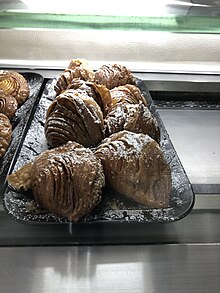The Raviola di ricotta nissena or Nissena ricotta ravioli is a fried dessert made with puff pastry and ricotta filling typical of the city of Caltanissetta; not to be confused with the fried raviola from Catania which is similar in shape but not in dough.
 | |
| Alternative names | Raviola nissena |
|---|---|
| Type | sweet |
| Place of origin | Italy |
| Region or state | Caltanissetta, Sicily |
| Main ingredients | sheep ricotta, honey |

This dessert, typical of the Nissena pastry tradition, is usually not produced in the summer.[1]
With the same ingredients without the ricotta filling, the guasteddra dolce nissena is produced.
Ingredients
editSoft wheat flour, sweetened sheep's ricotta, honey and strictly lard as a frying fat.
The dough is rolled out and flattened on a large marble table, then brushed with lard that must not be liquid, then rolled into a roll (very similar to a Swiss roll, but with many more layers). The disks are cut from the end, shaped to form disks that are filled with plenty of ricotta and then folded to form semi-circles. The pasta is cooked until the layers separate and color (see Maillard reaction), forming the characteristic ridges of the raviola.
Compared to the Neapolitan sfogliatella riccia,[2] the raviola di ricotta Nissena does not have the typical shell shape, it is much larger and heavier, generally no less than 200 gr, and is also brushed with plenty of melted honey that contrasts and blends with the flavor of the fried pasta.
Notes
edit- The lard prevents the preparation of the dessert in the summer due to the high temperatures.
See also
editReferences
edit- ^ "Make Your Day". TikTok. Retrieved 2024-10-12.
- ^ "Sfogliatella Napoletana". Pompi (in Italian). 2022-02-22. Retrieved 2024-10-12.
External links
edit- Salvatore Farina: Dolcezze di Sicilia. Arte cultura storia e tradizioni dei dolci e della pasticceria siciliana 2003, ISBN 88-8243-084-7
- Alba Allotta (18 September 2012). La cucina siciliana. Newton Compton Editori. pp. 608–. Retrieved October 12, 2024.
- Joël Robuchon (2009). Larousse Gastronomique: The World's Greatest Culinary Encyclopedia. Hamlyn.
- Gary Hunter; Terry Tinton; Patrick Carey (2008). Professional Chef: Level 3 S/NVQ. Cengage Learning EMEA. pp. 339–.
- Glenn Rinsky; Laura Halpin Rinsky (20 March 2014). The Pastry Chef's Companion: A Comprehensive Resource Guide for the Baking and Pastry Professional. Wiley. pp. 149–.